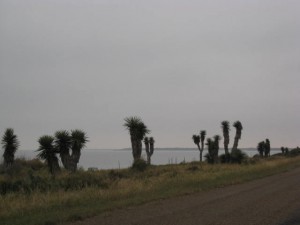 Today was my last day to sightsee in Texas, and although it was still overcast, thankfully, it was a bit warmer than yesterday. On the agenda for today were two birding sites, the Laguna Atascosa National Wildlife Refuge, and the Sabal Palm Sanctuary in Brownsville. Established in March 1946, Laguna Atascosa comprises nearly 90,000 acres in four units and serves as a sanctuary and management area for migratory birds. Under the auspices of the US Fish and Wildlife Service, the refuge also protects fish and wildlife.
Today was my last day to sightsee in Texas, and although it was still overcast, thankfully, it was a bit warmer than yesterday. On the agenda for today were two birding sites, the Laguna Atascosa National Wildlife Refuge, and the Sabal Palm Sanctuary in Brownsville. Established in March 1946, Laguna Atascosa comprises nearly 90,000 acres in four units and serves as a sanctuary and management area for migratory birds. Under the auspices of the US Fish and Wildlife Service, the refuge also protects fish and wildlife.
From South Padre Island, we drove west and then north, and in about a half hour, we arrived at the Visitor’s Center, where we picked up maps and a brochure. After considering our options, we decided to drive along Bayside Wildlife Drive, a 15 mile loop, with one-way vehicle traffic. According to the brochure, we would be driving through thorn forest, coastal prairies, then along the Laguna Madre shore. Along the mudflats, the literature informed us, we might see aplomado falcons, white-tailed hawks, or piping plovers. Inland, we might see deer, coyotes, or long-billed curlews, or if we were very lucky, the elusive ocelot. (In fact, we did see a deer and a coyote.)
Here is a typical view of the Laguna:

Just as we were about to return to our starting point, my sister spotted a Crested Caracara (Caracara cheriway)! What a thrilling sight that was. Back at the Visitor’s Center, I photographed these Green Jays (Cyanocorax yncas), another bird found in the US only in South Texas.

By then it was mid-afternoon, but we really wanted to visit Sabal Palm, so back to Brownsville we went, driving west on 510, south on 1847, then southeast on 511 to Southmost Road. Before we reached the Sanctuary, we saw the controversial Border Fence:
 At the Sabal Palm Sanctuary Visitor’s Center, lighted at dusk in this photo, we learned that the National Audubon Society had closed the Sanctuary in mid-2009. About a month ago, operational management was transferred to the Gorgas Science Foundation, and the Sanctuary re-opened to the public on January 3rd. Both locals and out-of-state nature enthusiasts were heartened at the news. A recent press release described the reserve:
At the Sabal Palm Sanctuary Visitor’s Center, lighted at dusk in this photo, we learned that the National Audubon Society had closed the Sanctuary in mid-2009. About a month ago, operational management was transferred to the Gorgas Science Foundation, and the Sanctuary re-opened to the public on January 3rd. Both locals and out-of-state nature enthusiasts were heartened at the news. A recent press release described the reserve:
The Sabal Palm Audubon Sanctuary sits on a 527-acre tract of land on the Rio Grande River [sic] in Brownsville and is one of the most uniquely biodiverse habitats in the country, containing one of the last vestiges of original Sabal Palm forest in the U.S. The Sanctuary provides breeding habitat for many endangered or high-priority birds and is a critical source of shelter and food for migrating and wintering species.
Here’s a photo of the Sanctuary’s namesake:

My sister and I were excited to see nine-banded armadillos (Dasypus novemcinctus), an iconic Texas mammal:

One of the critical tasks for the re-opening was diverting water back into the resaca, an oxbow of the Rio Grande, and thus restoring it as wetland habitat.

We wandered the trails for an hour or so, and shortly before the Sanctuary closed at 5, a staff member guided us along the newly buttressed boardwalk which allows visitors to birdwatch right at the water’s edge.
